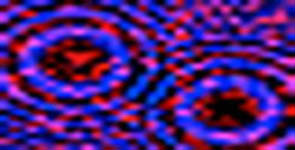|

"This entire living
universe is pervaded by me
in my unmanifested state.
At the end of a kalpa,
all beings merge into my nature,
then, at the beginning of the next kalpa,
I emit them again.
Mastering my own cosmic nature,
I emit them again and again all these beings,
in spite of them and by the power of my nature.
From me, its supervisor,
the nature give birth to the universe.
And this is the reason why the universe exists."
(IX, 4-15)
"Consider that
all these beings have this double nature as matrix.
I am the origin, and dissolution of the universe too."
(VII, 6)
"Veiled by my Maya magic and my
yogic power, I am not known by all. This ignorant world does
not know me as the Unborn, eternal."
(VII, 25)
"In all situations,
all acts are being done by the actvity of the constituent
qualities of nature. But due to the delusion of ego, the
soul believe to be the agent of this process. However, the
one who knows the double series of constituent qualities and
acts realise that it is simply an effect of qualities on
qualities; consequently he do not get attached to
them.
Deluded by the qualities
of the nature, the ordinary men get attached to the activity
of these qualities. Weak men, they have a fragmented
knowledge of the truth."
(III, 27-29)
"This magic, divine and made up
of the nature qualities, is unattainable. The ones who let
themselves go into me, these ones go beyond this magic."
(VII, 14)
"The ones who, taking refuge in
me, strive for freedom from old age and death, these ones
know Brahman, the whole self, the whole action.
The ones who kwow me among the beings, among the gods, and
at the moment of death too, these ones, with their unified
mind, know me."
(VII, 29-30)

"Now I shall explain to you my divine
manifestations, keeping me to the main things, because my
manifestations are endless.
I am the beginning,
the middle, and the end of all beings.
I am the death which sweep away everything, the source of
the coming things.
I am the power of the rulers, the political art of
conquerors, the silence among the secrets, the knowledge of
the knowledgeable.
And whatever the sape of all beings, I am them. Ther is
nothing, animate or inanimate, that can exist without
me."
(X, 19-39)
"I am the goal,
the supporter, the lord, the witness, the abode, the refuge,
the friend, the origin, the dissolution, the permanence, the
container, the seed, the perpetual.
I give heat, I send as well as I hold back the rain; I am
both immortality and death; I am also both being and
non-being."
(IX, 18-19)
"Discrimination, knowledge,
non-delusion, forgiveness, truthfulness, control over self,
pleasure and pain, existence and non-existence, fear and
fearlesness, non-violence, equanimity, contentment,
austerity, charity, honour and fame, all these diverse
qualities in human beings arise from me.
One who truly understand these manifestations and yogic
powers is united by an unwavering yoga, there is no doubts
about this."
(X, 4-7)

"I shall now describe what is
knowledgeable by knowledge, knowing wich one attains
immortality: the beginingless supreme Brahman is said to be
neither being nor non-being.
Without senses, the properties of all senses manifest him.
Unattached, yet the sustainer of all, without qualities he
experiment the qualities.
Inside as well as outside all beings, animate and inanimate,
he is incomprehensible because of his subtlety; he is very
near as well as far away.
Undivided, yet he appears as divided in beings.
(...)
He is said light of all lights,
beyond darkness; He is the knowledge, the subject of
knowledge, and the goal of knowledge. He resides in
everyone's heart.
(XIII, 12-26)
Whaterver is born,
animate or inanimate,
know them to be born from the union of the field
and the field knower.
(XIII, 26)

"Whatever the matrix in
which they are produced,
all beings with a shape arise from Brahman,
their common matrix."
(XIV, 4)
"All this universe of animate or
inanimate beings,
is deluded by these existence ways and behaviours.
(VII, 15)
"The one who sees the supreme Lord
dwelling equally within all these perishable beings
truly sees.
The one who sees the same Lord existing equally everywhere
(...)
attains the supreme goal.
When he comes to
discover that differences between beings are based on unity
and are a simple extension of this unity, then he reaches
the Brahman."
(XIII, 27-30)
"The one who forsake all his desires, go
back and forth, free from attachments, without saying: "It's
mine" or "I", this one attains peace."
(II, 39)
"As for the one whose action is motivated
by the fruit of the action dont le motif d'agir est le fruit
de l'action, they are to be pitied."
(II,
49)
"The one whose hapiness, joy, and light
are dwelling in himself rather than in external things, this
ascetic reaches the deep calm into Brahman."
(V,24)
"Satisfied with what he get by chance, he
has overcome the pair of the opposites, free from
selfishness, always the same man in success as in failure,
he can act without getting attached."
(IV, 22)
"The ascetic man in which all evil
intentions desappeared, who constantly controls and unify
himself, attain easily the infinite hapiness: to blend in
with Brahman."
(VI, 28)
His heart free from attachements to external
contacts, he founds his true hapiness in himself. His soul
united by his union with Brahman, he enjoys an imperishable
hapiness."
(V, 24)
|

The sense of balance, the inner unity, the harmony with nature, and the meaning of life, seen through the philosophy of Tao and the metaphor of surfing.
Our mental energy is not depend on the reality as much as on the way we are perceiving and representing this reality.

